The Upper
Mustang trip I just returned from was a huge success, but I still have a bunch
of photos to share from Mich’s and my short weekend trip to Bardia National
Park in southwestern Nepal.
We stayed at
the very friendly and well-run Racy Shade Resort in the far western edge of the
national park, the most accessible area and known for its tigers. In fact,
Bardia National Park may be the best place in the world to spot a tiger while
on foot.
We had a two
guides from the resort and were on foot for our one whole day here, and we put
on 11.2 miles, measured by my GPS. We were on roads, overgrown trails, and even
waded across a river.
We couldn’t
ignore the birds, but the main target was tiger. Early on, while walking on the
main entrance road, a group in front of us had heard alarm calls from a troop
of Rhesus Macaques, and they sat waiting, hoping for a tiger to cross the road.
It was a false alarm.
Cutting to
the chase, we saw two tigers, finally, at 3:54 p.m. We had situated ourselves
at a couple likely spots along a small, slow-flowing stream and waited along
with other tiger watchers, arriving at the first location at 9:45. We waited
and watched, changed locations, waited again, and then heard that a tiger briefly had
been seen crossing the stream just 60 meters from where we were waiting
sometime shortly before noon. So we persisted, waited more, had our picnic
lunch, napped, and finally gave up. We took off to totally different location on
another stream at 1:50 p.m., and at about 3:35 one of our guides got a call
that two tigers came out exactly were we had been waiting earlier. We were 1.3
km (over 3/4 of a mile) away, but got there breathless in 15 minutes to see two
tigers up to their bellies in the stream, perhaps 100 meters away.
They rarely
moved over the next 20 minutes or so, both facing away, but we were patient.
We were the
first to arrive, joining the four who first spotted them. But soon a large
crowd had gathered – largely foreigners, but one group of Nepali tourists,
including some children, had also arrived. Everyone was thrilled.
When the big
group of Nepalis left, we were a bit distracted and looked up to see that one
tiger had quickly vanished. The other remained virtually motionless for another
30 minutes, but finally it showed some life, turning its head, lapping up
water, and then it slowly got up and walked out of sight.
I took
several bits of video over the course of our 50 minutes and was lucky to get
the last hurrah.
Here are a
couple happy tiger watchers.
We birded of
course, tallying over 100 species in the national park, at our resort, and in
the community forest across from it. Green Bee-eater was a common bird in all
areas.
We saw a few
Stork-billed Kingfishers, but they were quite shy and didn’t allow close
approach.
Greater
Racket-tailed Drongos were conspicuous and very noisy inhabitants of the
canopy.
We flushed a
few wintering Tree Pipits in a grassy area, and they promptly flew up to land
in trees.
White-browed
Wagtails were along the rivers in the park as well as an irrigation ditch by
the resort.
This Black
Redstart, wintering here only (and breeding in the Himalayan highlands and
north to Mongolia), is a very different looking subspecies (Phoenicurus ochruros rufiventris) from
the resident birds I know from western Europe.
A very
common passerine in all woodland types here is the Common Iora, a pair of which
was building this very tidy nest in a tree across the drive from the Racy Shade.
A fruiting
fig tree near the resort hosted many birds, including a couple pairs of the common
Coppersmith Barbet.
The
community forest was great for woodpeckers. First we had a few of these Black-rumped
Flamebacks.
But the one
prize bird I had hoped to see eventually showed well when we found a family
group excavating a nest cavity: The world’s largest woodpecker, Great Slaty
Woodpecker.
The cavity
was about 3/4 the way up this tree on the right edge of the trail.
Besides
Tiger, we noted a few other mammals. Indian Muntjac is probably the tiger’s
main prey.
I mentioned
Rhesus Macaque, but the more attractive monkey here is the Terai Gray Langur.
This Indian
Rhinoceros appeared at the same location as the tigers, and as soon as it
emerged from the forest, an Indian Jungle Crow (clearly different from the
highland Large-billed Crows, though some lump them) landed on it.
I was able
to put names to all of the butterflies I photographed while waiting for tigers
to show. The Asian tropical regions have a very high diversity of Lycaenids – blue
and hairstreaks. The one on the left is Megisba
malaya, the Malayan, and on the right is Lestranicus transpecta, White-banded Hedge Blue.
Prosotas nora ardates, Common Lineblue
Jamides bochus, Indian Dark Cerulean
Ypthima inica, Lesser Threering, a
typical looking satyr
This
stunning brushfoot is Cyrestis thyodamas,
the Common Map.
This dragonfly
is Trithemis aurora, the Crimson
Marsh Glider.
Very common along the forest trails well away from water was this Neurothemis fulvia, Fulvous Forest Skimmer.
The name
suggested on Mushroomobserver.org for this fungus is Trametes betulina, but I’m not convinced that is correct.
Adding a
wonderful fragrance along all of the trails in the park was this Clerodendrum infortunatum, Hill Glory
Bower.
I recognized
this Calotropis gigantea, Giant
Milkweed, from having seen it in Jamaica, Hawaii, and Indonesia.
This
epiphytic orchid was common in the community forest, and it appears to be Vanda tessellata.
A typical
scene while were birding in the lands near our lodge.
We had a
late afternoon flight from Nepalgunj to Kathmandu, so we had much of our last
day to stop along the drive and look for birds. We drove though lots of
agricultural land and around noon arrived at the little-known Blackbuck
Conservation Area, a tiny reserve. And indeed here were many rather tame Antilope cervicapra, the Blackbuck, a
species that would have disappeared from Nepal without this reserve.
Our prize
find here were seven Indian Coursers, an extremely scarce and amazingly
attractive bird of open country.
Blue-tailed
Bee-eaters were also at Bardia, but they were particularly common here.
Crested Lark
is a very rare bird in Nepal, and this was Mich’s first in the county; I had
seen it only in western Europe before.
Yellow-wattled
Lapwing is yet another very hard bird to find in Nepal, but there were several
in the reserve.
Long-tailed
Shrike is common in lots of habitats in much of the country; this is the
subspecies Lanius schach erythronotus,
lacking the black crown of birds from eastern Nepal.
I scooped
Mich on this Indian Hare which darted off and disappeared before he could see
it.
Lizard
diversity doesn’t seem so high here, and Calotes
versicolor, the Oriental Garden Lizard seems to occur everywhere.
We made a short
stop at a bridge on our way to Nepalgunj and I added two lifers: Ashy-crowned
Sparrow-Lark…
…and Bank
Myna, both of which are common in much of India but only barely make it into this
part of Nepal.









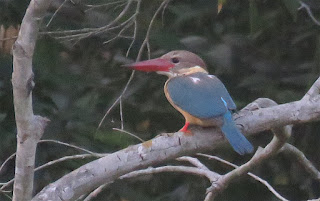
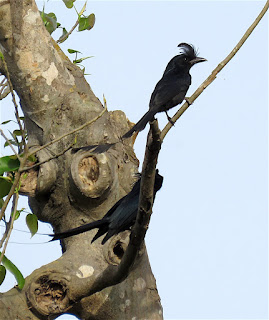

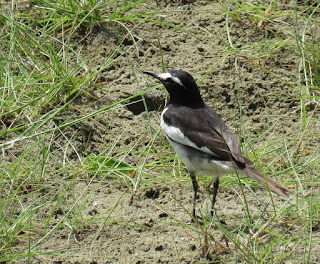

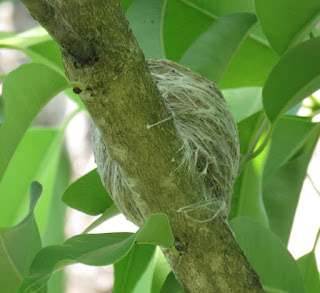

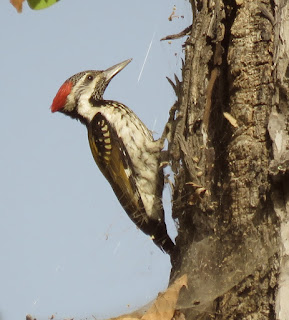



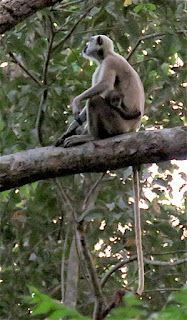

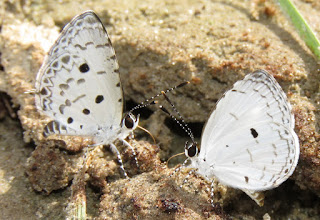


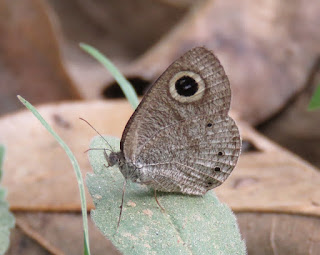





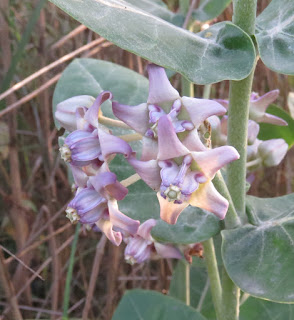
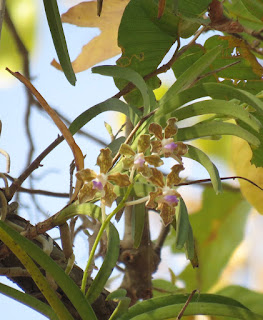


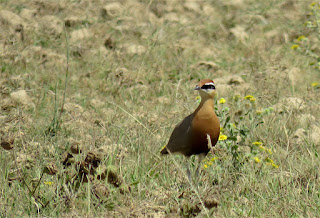

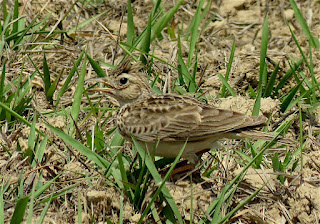


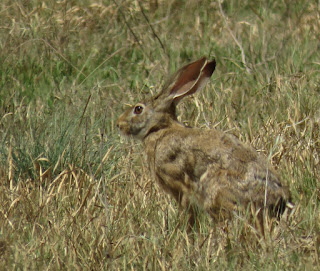


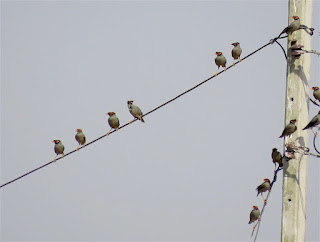





No comments:
Post a Comment